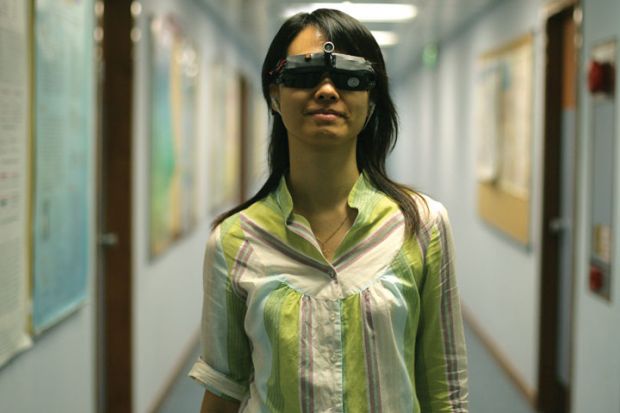Technology is transforming the experience of visually impaired students in higher education – as Ellen Watson can attest.
“When I first started, a lot of books, even the core readings, weren’t electronic so you had to have one-to one-support to get those books in an accessible format,” said Ms Watson, who has Usher syndrome and started losing her sight at the age of 16. “By the end of my degree, I did two dissertations and nearly all of the sources I used for both of them were available online.”
As a student at the University of Sheffield between 2014 and last year, Ms Watson – who is today supported in her work as a clerk at the House of Commons by her guide dog, Skipp – had a large magnifier in her bedroom for reading printed documents. She also had a handheld magnifier and specialist software to enlarge and colour-invert online documents.
Now she can turn her iPhone camera into a magnifier at the click of a button, and computers have inbuilt functions that make reading documents easier.
More specialist tools are also opening doors to subjects that were traditionally closed off to visually impaired learners: specially designed glasses can enable an art student to look around galleries when they would traditionally have needed to have art described to them, and to paint models and objects that are at a distance. Advanced text-to-speech software can allow physics students to grapple with formulae that would usually have been written by hand, or visualise graphics through advanced Braille embossers.
This can have a significant impact: a 2017 study by the Royal National Institute of Blind People found that having a degree increases sevenfold the chance of registered blind and partially sighted people being in employment, from 6 per cent to 43 per cent.
However, universities need to match these innovative solutions with the policies, training and resources needed to support these students and create meaningful change in accessibility – and this doesn’t always happen.
In particular, assistance can be adopted inconsistently across an institution. Despite Ms Watson having a disability learning support plan stating that she needed PowerPoint presentations in advance, handouts in large print and shorter reading lists, she said that some of her tutors were unwilling to make such accommodations.
“I [am] someone who constantly advocates for myself, and [sends] email after email. But a lot of people with access needs don’t have the capacity to do that,” Ms Watson said. “Academia seems to think [it is] exempt from the rules. My experience came down hugely to a tutor-by-tutor basis. A few would go above and beyond and those are the people who got me through university.”
Some institutions are leading the way. Swansea University has a transcription centre that provides all learning materials in accessible formats free of charge to print-disabled students.
For Kirsty Hill, a psychology PhD student with Fraser syndrome, which means she is registered deafblind as well as having other physical disabilities with her hands and breathing, this is a major attraction. She also took her undergraduate and master’s degrees at Swansea.
“University seemed like a massive jump from both school and college, and I was a bit worried about what kind of support I might be able to get,” Ms Hill said. “Swansea was brought to my attention as somewhere that offered great support.”
Tina Webber, who manages Swansea’s transcription centre, said that the biggest challenge was adapting the service to disciplines that, without recent technological developments, would have been near-impossible for partially sighted people to study.
“We’re supporting students who are doing theoretical physics or engineering, some of which are still taught in a very traditional way – physics, for instance, where formulae would be developed on a blackboard,” Ms Webber said.
But, she added, some departments and universities still do not consider the implications of taking on a visually impaired student, and the way that courses – and, for example, field trips, computer programs and laboratory experiments – may have to be adapted.
Rather than making exceptions for individual disabled students, universities should strive to make all curricula universally accessible, interviewees said.
“If you install a lift, that means a wheelchair user can use it. It also means that people who break a leg can get into work, or people who have a pram can get in,” Ms Watson said. “And it’s the same concept here. If a class is accessible to one person with a specific need, it’s accessible to everyone.”
后记
Print headline: Put visually impaired people in the picture
